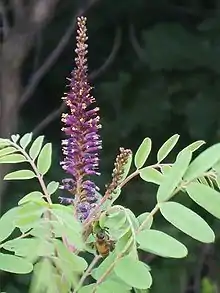| Amorpha fruticosa | |
|---|---|
 | |
| Scientific classification | |
| Kingdom: | Plantae |
| Clade: | Tracheophytes |
| Clade: | Angiosperms |
| Clade: | Eudicots |
| Clade: | Rosids |
| Order: | Fabales |
| Family: | Fabaceae |
| Subfamily: | Faboideae |
| Genus: | Amorpha |
| Species: | A. fruticosa |
| Binomial name | |
| Amorpha fruticosa | |
| Synonyms | |
| |
Amorpha fruticosa is a species of flowering plant in the legume family Fabaceae, known by several common names, including desert false indigo, false indigo-bush, and bastard indigobush.[2] It is native to North America.
Description
Amorpha fruticosa is a perennial shrub.[3] It grows as a glandular, thornless shrub which can reach 5 or 6 m (16 or 20 ft) in height and spread to twice that in width. It is somewhat variable in morphology. The leaves are made up of many hairy, oval-shaped, spine-tipped leaflets. The inflorescence is a spike-shaped raceme of many flowers, each with a single purple petal and ten protruding stamens with yellow anthers. The fruit is a legume pod containing one or two seeds.[4]
Distribution and habitat
The native range extends through much of the United States and south into Mexico.[5] Its native habitats include stream and pond edges, open woods, roadsides and canyons.[3]
The species has escaped cultivation elsewhere and is present as an introduced species in Europe,[6] Asia, and other continents. It is often cultivated as an ornamental plant, and some wild populations may be descended from garden escapes.

Chemistry
6'-O-β-D-glucopyranosyl-12a-hydroxydalpanol, a rotenoid, can be found in the fruits of A. fruticosa.[7] Several members of the amorfrutin class of compounds have been isolated from the fruits.[8] Amorfrutins as well as other secondary metabolites from A. fruticosa have displayed favorable bioactivities counteracting diabetes and the metabolic syndrome.[9]
Ecology
It is a larval host to the clouded sulphur, gray hairstreak, hoary edge, Io moth, marine blue, silver-spotted skipper, and southern dogface.[10] The plentiful seeds are a food source for bobwhite quail. Both bees and butterflies use the flowers as a nectar source.[11]
Cultivars
- 'Albiflora', with white flowers
- 'Crispa', with curled leaves
- 'Lewisii', with narrow leaves
- 'Pendula', with arching branches, forming a dome shape
References
- ↑ "NatureServe Explorer 2.0". explorer.natureserve.org. Retrieved 2023-10-23.
- ↑ "Amorpha fruticosa". Germplasm Resources Information Network. Agricultural Research Service, United States Department of Agriculture.
- 1 2 "Lady Bird Johnson Wildflower Center - The University of Texas at Austin". www.wildflower.org. Retrieved 2022-01-06.
- ↑ "Western False Indigo, Amorpha fruticosa". calscape.org. Archived from the original on 2017-12-16.
- ↑ "Amorpha fruticosa L. | Plants of the World Online | Kew Science". Plants of the World Online. Retrieved 2022-10-14.
- ↑ DAISIE (2009). Handbook of Alien Species in Europe. Dordrecht: Springer. p. 399. ISBN 978-1-4020-8279-5.
- ↑ Hak Ju Lee; Ha Young Kang; Cheol Hee Kim; Hyo Sung Kim; Min Chul Kwon; Sang Moo Kim; Il Shik Shin; Hyeon Yong Lee (2007). "Effect of new rotenoid glycoside from the fruits of Amorpha fruticosa LINNE on the growth of human immune cells". Cytotechnology. 52 (3): 219–226. doi:10.1007/s10616-006-9040-5. PMC 3449409. PMID 19002880.
- ↑ Weidner, C.; De Groot, J. C.; Prasad, A.; Freiwald, A.; Quedenau, C.; Kliem, M.; Witzke, A.; Kodelja, V.; Han, C.-T.; Giegold, S.; Baumann, M.; Klebl, B.; Siems, K.; Muller-Kuhrt, L.; Schurmann, A.; Schuler, R.; Pfeiffer, A. F. H.; Schroeder, F. C.; Bussow, K.; Sauer, S. (2012). "Amorfrutins are potent antidiabetic dietary natural products" (PDF). Proceedings of the National Academy of Sciences. 109 (19): 7257–62. Bibcode:2012PNAS..109.7257W. doi:10.1073/pnas.1116971109. PMC 3358853. PMID 22509006.
- ↑ Kozuharova, E; Matkowski, A; Woźniak, D; Simeonova, R; Naychov, Z; Malainer, C; Mocan, A; Nabavi, SM; Atanasov, AG (June 8, 2017). "Amorpha fruticosa - A Noxious Invasive Alien Plant in Europe or a Medicinal Plant against Metabolic Disease?". Frontiers in Pharmacology. 8: 333. doi:10.3389/fphar.2017.00333. PMC 5462938. PMID 28642702.
- ↑ The Xerces Society (2016), Gardening for Butterflies: How You Can Attract and Protect Beautiful, Beneficial Insects, Timber Press.
- ↑ Kurz, Don (2004). Shrubs and Woody Vines of Missouri (Second ed.). Conservation Commission of the State of Missouri. p. 48. ISBN 1-887247-44-0.
External links
![]() Media related to Amorpha fruticosa at Wikimedia Commons
Media related to Amorpha fruticosa at Wikimedia Commons
- Jepson Manual Treatment
- USDA Plants Profile
- "Amorpha fruticosa". Germplasm Resources Information Network. Agricultural Research Service, United States Department of Agriculture.
- Amorpha fruticosa L. Medicinal Plant Images Database (School of Chinese Medicine, Hong Kong Baptist University) (in Chinese) (in English)
